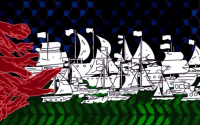19 March 2006Geoffrey Lean, Jonathan Owen and Marie Woolf
Hunters are preparing to kill more than 300,000 baby seals this week despite growing international protests against the world's largest massacre of marine mammals and a new threat to the animals from global warming.
Canada's bloody annual slaughter - the most controversial for decades - takes place as calls mount for a boycott of the country's products. But the long-term future of the cull and the seals themselves looks increasingly likely to be dictated by climate change.
Hunters and protesters are heading for the Gulf of St Lawrence and the north-east coast of Newfoundland, waiting for the Canadian government to give the go-ahead for the cul. It could start as early as tomorrow.
Ministers have already authorised the slaughter of 325,000 baby harp seals, the second highest number ever. It will be the third successive year in which more than 300,000 of the cubs have been clubbed and shot; by the end of the cull, the death toll since 2004 will top a million.
But the cull faces the most determined opposition for decades. Attempts to launch a global boycott against Canadian exports start in Britain this week. Major supermarkets will tomorrow receive letters urging them to stop stocking Canadian produce, and vigils will start outside travel agencies in 20 cities, trying to persuade Britons not to holiday in the country.
The supermarket campaign is being led by Lady (Sally) Stratford, widow of the former Labour minister Tony Banks, who was an ardent opponent of the cull. The former Tory minister Ann Widdecombe has also written to retailers to urge a boycott, and 188 MPs have signed an early day motion to support it.
The campaign has been boosted by the decision of Sir Paul McCartney and his wife, Heather, to travel to the floes this month to call for the cull to be called off. His daughter, the designer Stella McCartney, will give some of the proceeds from sales of a special T-shirt to the campaign.
The boycott began last year in the United States, supported by more than 400 restaurants, supermarkets and seafood wholesalers. This year it is expected to spread to France, Germany, Spain, Denmark, Mexico, Japan and the Netherlands.
The protesters are hoping to repeat a boycott of the early 1980s, which pushed Canada into banning the killing of the youngest pups, called whitecoats. But the hunters now evade the ban by waiting a few days until the seals begin to moult and their coats turn grey.
Canada is vulnerable to a boycott. It exports fish and seafood worth £1.6bn to the United States every year, while its fish exports to Britain are worth £56m, far outweighing the £9m value of seal skins and other hunt booty.
The Humane Society of the United States, the country's leading animal protection charity, claims that the value of Canadian snow crab exports have dropped by £85m since the boycott began last year.
Many scientists, though, claim the real danger to the seals comes from climate change. Water temperatures off Newfoundland are 4.5C warmer than this time last year and the ice is already beginning to melt. Dr Kit Kovacs, who is to take over as chair of the main international scientific group monitoring seals in June, said: "Harp seals are a numerous Arctic species. But there is concern because of climate change and things don't look good in the long term."
The danger to the hunters will also increase as they venture out on ever-thinning ice. That could mean an end to one of the most chilling images deployed by the anti-cull campaigners, for the Canadian government says hunters will soon be unable to get close enough to many of the pups to club them. Instead, more will be shot.
THE CASE FOR A CULL ...
METHOD The majority of seals are already shot, not clubbed to death. In 2002, the Canadian Veterinary Medical Association issued a "Special Report on Animal Welfare and the Harp Seal Hunt in Atlantic Canada", which concluded that virtually all harp seals are killed "humanely".
POPULATION Harp seals are not an endangered species. There are currently 5.8 million animals and the herd is three times the size it was in the 1970s. Culling quotas are set at levels designed to keep the herd sustainable and stable.
NECESSITY The seal hunt supports about 15,000 sealers and their families in eastern Canada, and also brings economic benefits to remote, coastal communities where there are only limited employment opportunities. Sealing has become an increasingly important economic activity , especially in Atlantic Canada, because overfishing has depleted fish stocks and there has been a moratorium on cod since 1992.
PUBLIC OPINION An opinion poll in February 2005 concluded that 60 per cent of Canadians are in favour of a responsible seal hunt.
... THE CASE AGAINST
METHOD Seal cubs are clubbed to death or shot, many while still conscious. A veterinarian report in 2001 found that almost half of the seals it examined seemed to have been conscious when skinned, causing "considerable and unacceptable suffering". In the past three years 97 per cent of seals killed were less than three months old.
POPULATION More than 300,000 seal cubs are to be slaughtered this year. Almost one million pups have been killed in the past three years.
NECESSITY In Newfoundland, where more than 90 per cent of the sealers live, the cull accounts for less than 1 per cent of that province's GDP and amounts to only 2 per cent of the value of the province's fishery. Only 4,000 fishermen, out of a population of half a million, take part in the hunt.
PUBLIC OPINION Recent polling for the Humane Society International suggests that 48 per cent of the public would support their supermarket boycotting Canadian seafood in an effort to stop the annual cull.






